Papers by Luchuo Engelbert Bain
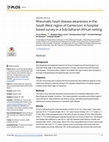
PLOS ONE, 2018
Background Early diagnosis and adequate treatment of Group A streptococcal throat infection is an... more Background Early diagnosis and adequate treatment of Group A streptococcal throat infection is an important initial stage in the primary prevention of acute rheumatic fever and rheumatic heart disease. This preventable condition associated with high mortality rates mandates a thorough understanding by the general public and the health. Objective The aim of the study was to assess the level of awareness about different aspects of rheumatic heart disease in patients coming to the outpatient department of the Buea regional Hospital, South West region of Cameroon. Methods This was a cross-sectional descriptive study carried in the outpatient department of the Buea Regional Hospital, Cameroon. The study population was adults and children aged 9 years and above. Data collection was done by using a self-administered questionnaire addressed to assess awareness on rheumatic heart disease. Results A total of 256 participants were interviewed, of which 70 (27.3%) were males. Their mean age was 34.4 ± 11.9 years (males: 36.2 ± 12.7 years versus females: 33.7 ± 11.6 years, p = 0.129). Most of the participants were in the 20 to 29 year old group (37.9%). More than two thirds (71.1%) of the participants reported having had sore throat at least once. The disease was treated with antibiotics in only 45.4%, with the treatment prescribed by a health care professional in 35.8% of the cases. About 73% of the respondents did not know what causes sore throat, and most (71.1%) were unaware of any complications that could arise from poorly treated sore throat. More than 70% of the participants did not know that sore throat
Pan African Medical Journal
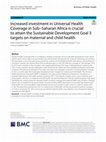
Archives of Public Health
Universal Health Coverage (UHC) is considered a strategic component of the Sustainable Developmen... more Universal Health Coverage (UHC) is considered a strategic component of the Sustainable Development Goals specifically for goal 3 which seeks to ensure healthy lives and promote well-being for all, where all individuals and communities have equal access to key promotive, preventive, curative, and rehabilitative health interventions without financial constraints. Despite Sub-Saharan Africa (SSA) accelerated gains on the UHC effective coverage of 2.6% between 2010 to 2019, many countries in the sub-region show lagging performance. The major challenges faced in attaining the UHC in many countries include inadequate capital investment for health and their equitable distribution, fiscal space to finance UHC policies and programs. This paper discusses how increased investment in Universal Health Coverage in SSA is crucial to attain the Sustainable Development Goal 3 targets on maternal and child health. The Universal Health Monitoring Framework (UHMF) is adopted in this paper as the underp...
Pan African Medical Journal
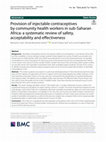
Human Resources for Health
Background Injectable contraceptives are the most popular method of contraception in sub-Saharan ... more Background Injectable contraceptives are the most popular method of contraception in sub-Saharan Africa (SSA), but their availability in clinical settings has been severely limited, despite the scarcity of health care providers and limited access to health facilities. WHO and USAID have endorsed the community-based distribution of injectable contraceptives as a promising option for improving access to family planning services and expanding the method mix for women who want to limit the number of births. Studies have shown that community health workers (CHWs) can provide women with injectable contraceptives that meet acceptable quality standards. The goal of this study is to identify, evaluate and synthesize evidence supporting the use of community-based administration of injectable contraceptives in SSA. Methods This review's guidance was based on a previously developed protocol. Nine international electronic databases and the websites of organizations known to support community...
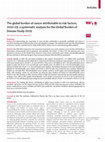
The Lancet
Background Understanding the magnitude of cancer burden attributable to potentially modifiable ri... more Background Understanding the magnitude of cancer burden attributable to potentially modifiable risk factors is crucial for development of effective prevention and mitigation strategies. We analysed results from the Global Burden of Diseases, Injuries, and Risk Factors Study (GBD) 2019 to inform cancer control planning efforts globally. Methods The GBD 2019 comparative risk assessment framework was used to estimate cancer burden attributable to behavioural, environmental and occupational, and metabolic risk factors. A total of 82 risk-outcome pairs were included on the basis of the World Cancer Research Fund criteria. Estimated cancer deaths and disability-adjusted life-years (DALYs) in 2019 and change in these measures between 2010 and 2019 are presented. Findings Globally, in 2019, the risk factors included in this analysis accounted for 4•45 million (95% uncertainty interval 4•01-4•94) deaths and 105 million (95•0-116) DALYs for both sexes combined, representing 44•4% (41•3-48•4) of all cancer deaths and 42•0% (39•1-45•6) of all DALYs. There were 2•88 million (2•60-3•18) risk-attributable cancer deaths in males (50•6% [47•8-54•1] of all male cancer deaths) and 1•58 million (1•36-1•84) risk-attributable cancer deaths in females (36•3% [32•5-41•3] of all female cancer deaths). The leading risk factors at the most detailed level globally for risk-attributable cancer deaths and DALYs in 2019 for both sexes combined were smoking, followed by alcohol use and high BMI. Risk-attributable cancer burden varied by world region and Socio-demographic Index (SDI), with smoking, unsafe sex, and alcohol use being the three leading risk factors for risk-attributable cancer DALYs in low SDI locations in 2019, whereas DALYs in high SDI locations mirrored the top three global risk factor rankings. From 2010 to 2019, global risk-attributable cancer deaths increased by 20•4% (12•6-28•4) and DALYs by 16•8% (8•8-25•0), with the greatest percentage increase in metabolic risks (34•7% [27•9-42•8] and 33•3% [25•8-42•0]). Interpretation The leading risk factors contributing to global cancer burden in 2019 were behavioural, whereas metabolic risk factors saw the largest increases between 2010 and 2019. Reducing exposure to these modifiable risk factors would decrease cancer mortality and DALY rates worldwide, and policies should be tailored appropriately to local cancer risk factor burden. Funding Bill & Melinda Gates Foundation.

The Lancet Infectious Diseases
Background The global burden of lower respiratory infections (LRIs) and corresponding risk factor... more Background The global burden of lower respiratory infections (LRIs) and corresponding risk factors in children older than 5 years and adults has not been studied as comprehensively as it has been in children younger than 5 years. We assessed the burden and trends of LRIs and risk factors across all age groups by sex, for 204 countries and territories. Methods In this analysis of data for the Global Burden of Diseases, Injuries, and Risk Factors Study (GBD) 2019, we used clinician-diagnosed pneumonia or bronchiolitis as our case definition for LRIs. We included International Classification of Diseases 9th edition codes 079.6, 466–469, 470.0, 480–482.8, 483.0–483.9, 484.1–484.2, 484.6–484.7, and 487–489 and International Classification of Diseases 10th edition codes A48.1, A70, B97.4–B97.6, J09–J15.8, J16–J16.9, J20–J21.9, J91.0, P23.0–P23.4, and U04–U04.9. We used the Cause of Death Ensemble modelling strategy to analyse 23 109 site-years of vital registration data, 825 site-years of sample vital registration data, 1766 site-years of verbal autopsy data, and 681 site-years of mortality surveillance data. We used DisMod-MR 2.1, a Bayesian meta-regression tool, to analyse age–sex-specific incidence and prevalence data identified via systematic reviews of the literature, population-based survey data, and claims and inpatient data. Additionally, we estimated age–sex-specific LRI mortality that is attributable to the independent effects of 14 risk factors. Findings Globally, in 2019, we estimated that there were 257 million (95% uncertainty interval [UI] 240–275) LRI incident episodes in males and 232 million (217–248) in females. In the same year, LRIs accounted for 1·30 million (95% UI 1·18–1·42) male deaths and 1·20 million (1·07–1·33) female deaths. Age-standardised incidence and mortality rates were 1·17 times (95% UI 1·16–1·18) and 1·31 times (95% UI 1·23–1·41) greater in males than in females in 2019. Between 1990 and 2019, LRI incidence and mortality rates declined at different rates across age groups and an increase in LRI episodes and deaths was estimated among all adult age groups, with males aged 70 years and older having the highest increase in LRI episodes (126·0% [95% UI 121·4–131·1]) and deaths (100·0% [83·4–115·9]). During the same period, LRI episodes and deaths in children younger than 15 years were estimated to have decreased, and the greatest decline was observed for LRI deaths in males younger than 5 years (–70·7% [–77·2 to –61·8]). The leading risk factors for LRI mortality varied across age groups and sex. More than half of global LRI deaths in children younger than 5 years were attributable to child wasting (population attributable fraction [PAF] 53·0% [95% UI 37·7–61·8] in males and 56·4% [40·7–65·1] in females), and more than a quarter of LRI deaths among those aged 5–14 years were attributable to household air pollution (PAF 26·0% [95% UI 16·6–35·5] for males and PAF 25·8% [16·3–35·4] for females). PAFs of male LRI deaths attributed to smoking were 20·4% (95% UI 15·4–25·2) in those aged 15–49 years, 30·5% (24·1–36·9) in those aged 50–69 years, and 21·9% (16·8–27·3) in those aged 70 years and older. PAFs of female LRI deaths attributed to household air pollution were 21·1% (95% UI 14·5–27·9) in those aged 15–49 years and 18·2% (12·5–24·5) in those aged 50–69 years. For females aged 70 years and older, the leading risk factor, ambient particulate matter, was responsible for 11·7% (95% UI 8·2–15·8) of LRI deaths. Interpretation The patterns and progress in reducing the burden of LRIs and key risk factors for mortality varied across age groups and sexes. The progress seen in children younger than 5 years was clearly a result of targeted interventions, such as vaccination and reduction of exposure to risk factors. Similar interventions for other age groups could contribute to the achievement of multiple Sustainable Development Goals targets, including promoting wellbeing at all ages and reducing health inequalities. Interventions, including addressing risk factors such as child wasting, smoking, ambient particulate matter pollution, and household air pollution, would prevent deaths and reduce health disparities.
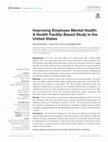
Frontiers in Public Health
BackgroundIn the US, over 52.9 million (21%) adults lived with a mental health illness in 2020, w... more BackgroundIn the US, over 52.9 million (21%) adults lived with a mental health illness in 2020, with depression, being one of the commonest of these conditions. The World Health Organization ranks depression as the most important contributor to global disability. As frontline workers who are responsible for taking care of a myriad of patients daily, health workers are usually exposed to depressive situations which eventually result in the development of the condition among them. This study, therefore, developed an intervention to reduce depression among workers at the Outpatient Mental Health Clinic in Washington District of Columbia, United States.MethodsA pre-intervention survey was conducted among 43 employees. The survey used the already validated Patient Health Questionnaire depression scale (PHQ-9) to determine the prevalence of depression. The WHO Healthy Workplace Model was adopted in designing an instrument for the workplace determinants of depression. An mHealth interventi...
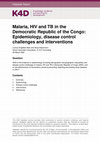
Malaria, human immune deficiency virus (HIV) and tuberculosis (TB) are leading causes of death an... more Malaria, human immune deficiency virus (HIV) and tuberculosis (TB) are leading causes of death and public health threat to millions in Democratic Republic of Congo (DRC). The DRC is the second most malaria affected sub-Saharan African country after Nigeria, with malaria being the leading cause of death in children under 5 years (Lechthaler et al., 2019). The HIV prevalence in the country in the adult population stands at 1%, with extensive variations by region (UNAIDS, 2021c). The DRC is considered a high burden country for TB and HIV infection (Linguissi et al., 2017). This rapid review emphasizes significant elements of the epidemiology of malaria, HIV, and TB in DRC, as well as limitations in prevention, detection, and treatment, and examines a few interventions that aim to address these limitations. Evidence utilised is a mixture of the most recent grey literature NGO (programme reports and related documents) literature supplemented by peer reviewed academic literature from the ...
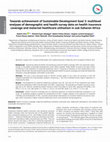
International Health, 2022
Background Improving maternal health and achieving universal health coverage (UHC) are important ... more Background Improving maternal health and achieving universal health coverage (UHC) are important expectations in the global Sustainable Development Goals (SDGs) agenda. While health insurance has been shown as effective in the utilisation of maternal healthcare, there is a paucity of literature on this relationship in sub-Saharan Africa (SSA). We examined the relationship between health insurance coverage and maternal healthcare utilisation using demographic and health survey data. Methods This was a cross-sectional study of 195 651 women aged 15–49 y from 28 countries in SSA. We adopted bivariable and multivariable analyses comprising χ2 test and multilevel binary logistic regression in analysing the data. Results The prevalence of maternal healthcare utilisation was 58, 70.6 and 40.7% for antenatal care (ANC), skilled birth attendance (SBA) and postnatal care (PNC), respectively. The prevalence of health insurance coverage was 6.4%. Women covered by health insurance were more like...
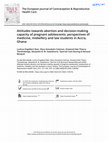
The European Journal of Contraception & Reproductive Health Care, 2020
Objectives: Because medical, midwifery and law students in Ghana constitute the next generation o... more Objectives: Because medical, midwifery and law students in Ghana constitute the next generation of health care and legal practitioners, this study aimed to evaluate their attitudes towards abortion and their perceptions of the decision-making capacity of pregnant adolescents. Methods: We conducted a cross-sectional survey among 340 medical, midwifery and law students. A pretested and validated questionnaire was used to collect relevant data on respondents' sociodemographic characteristics, attitudes towards abortion and the perceived capacity and rationality of pregnant adolescents' decisions. The v 2 test of independency and Fischer's exact test were used where appropriate. Results: We retained 331 completed questionnaires for analysis. Respondents' mean age was 21.0 ± 2.9 years and the majority (95.5%) were of the Christian faith. Women made up 77.9% (n ¼ 258) of the sample. Most students (70.1%) were strongly in favour of abortion if it was for health reasons. More than three-quarters (78.0%) of the students strongly disagreed on the use of abortion for the purposes of sex selection. Most respondents (89.0%) were not in favour of legislation to make abortion available on request for pregnant adolescents, with medical students expressing a more negative attitude compared with law and midwifery students (p < 0.001). Over half of the midwifery students (52.6%) believed that adolescents should have full decision-making capacity regarding their pregnancy outcome, compared with law and medical students (p < 0.001). Conclusion: Tensions between adolescent reproductive autonomy, the accepted culture of third party involvement (parents and partners), and the current abortion law may require keen reflection if an improvement in access to safe abortion services is envisioned.
© Luchuo Engelbert Bain et al. The Pan African Medical Journal- ISSN 1937-8688. This is an Open A... more © Luchuo Engelbert Bain et al. The Pan African Medical Journal- ISSN 1937-8688. This is an Open Access article distributed under the terms of the Creative Commons Attribution License

Pan African Medical Journal, 2021
Introduction adolescent pregnancy in Ghana, like in most low and middle income countries, is an i... more Introduction adolescent pregnancy in Ghana, like in most low and middle income countries, is an issue of immense public health importance. Pregnant adolescents are faced with the stronger dilemma of either terminating the unwanted pregnancy or keeping it. This discourse which is based on findings from empirical research in Accra Ghana aims at contributing to the usefulness of understanding the meaning and scope of autonomy when it comes to providing ethically grounded, and adolescent friendly, reproductive health care services to pregnant adolescents. The aim of this work was to document the meaning and determinants of autonomous decision making among pregnant adolescents in the James Town area of Accra, Ghana. Methods thirty (30) semi-structured in depth interviews were conducted among adolescents who had been pregnant at least once, 23 in depth interviews among purposively selected stakeholders (parents, teachers, NGO staff working in reproductive health, community volunteers), and 8 focus group discussions among parents, teachers, adolescent students who had not been pregnant before, and adolescents who had at least one pregnancy in the past. Data were transcribed verbatim and analyzed thematically. Results most adolescents reported that the final decision to continue a pregnancy to term or go in for an abortion was taken by them. The partner´s willingness to take responsibility of the pregnant adolescent and baby, as well as financial considerations, were main players in deciding upon the pregnancy outcomes. Cultural desirability for children and health care provider/father paternalism (power dynamics) in the decision-making process were central considerations in the decision-making process. Unaffordable and unfriendly safe abortion services pushed adolescents to either continue pregnancies to term against their will, or opt to visit unsafe abortion care providers. Conclusion adolescents stand to make truly autonomous decisions if they are provided with the right information, at the right time, at the right place, by the right persons, and in the right way. Health system, economic, and cultural factors play significant roles in rendering pregnant adolescent autonomy meaningful when deciding upon their pregnancy outcomes. Continuing pregnancies to term against one´s will or being forced to go in for an abortion are ethically unjustified. Further research is required to examine the long-term consequences of forced pregnancy terminations or births.
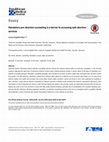
Pan African Medical Journal, 2020
Empirical research showcases that pre-abortion counseling scarcely reverses the woman's decision ... more Empirical research showcases that pre-abortion counseling scarcely reverses the woman's decision either to terminate a pregnancy or not. Growing evidence regarding the high levels of decisional certainty among women seeking abortions renders a careful rethink of the place of mandatory preabortion counseling packages. Mandatory counseling packages, when inscribed in the laws, at times contain false information that can deter women from going in for safe abortions. Mandatory waiting times indirectly label opting for an abortion as not being the right thing to do. In areas where abortion stigma from health care providers and communities remains highly prevalent, women are forced to incur extra expenses by travelling to other countries. I argue that pre-abortion counseling on opting-in grounds is ethically sound (enhances the woman's reproductive autonomy), since most clients in need of abortions are certain on their decisions before the abortion care provider and do not regret these decisions after the process. Regrets are prone to be more prevalent in areas with high unsafe abortion practices, generally due to complications from excessive bleeding, pain, and post abortion infections. Allowing systematic mandatory pre-abortion counseling practice as the rule in a competent adult is unjustified ethically and empirically, is time consuming and presents the legality of abortions in most settings an oxymoron.
Pan African Medical Journal, 2020
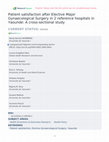
Introduction Patient satisfaction is a quality of care measure and reveals patients’ appreciation... more Introduction Patient satisfaction is a quality of care measure and reveals patients’ appreciation of healthcare delivery. We sought to measure patient satisfaction following major gynaecological surgeries in 2 University Teaching Hospitals in Yaounde, Cameroon.Methods Ours was a cross-sectional, prospective study over 9 months (October 1 st 2018, to June 30 th 2018) at the Yaounde Gynaeco-Obstetric and Paediatric Hospital (YGOPH) and the Yaounde Central Hospital (YCH). By administering a modified Surgical Satisfaction Questionnaire (SSQ-8) via phone call 6 months after surgery we appreciated and scored key aspects linked to patient satisfaction, and obtained information on post-operative complications. Data was analysed using Microsoft Excel 18 and SPSS 21 setting significance at p<0.05.Results We recruited 72 patients aged 24 to 68 years. Our participants had a mean satisfaction score of 26 ± 7.854 (59.7% satisfied and 40.3% dissatisfied). All aspects tested on the SSQ-8 questio...
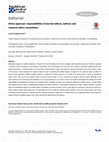
Pan African Medical Journal, 2017
Meaningful progress of medicine depends on research that must ultimately involve human subjects. ... more Meaningful progress of medicine depends on research that must ultimately involve human subjects. Obtaining ethical approval therefore, especially in medical sciences, should be a moral reflex for researchers. This unfortunately is not the case, with numerous researchers bypassing the ethics approval procedure, or simply unaware of its importance. Good research involves risks taken by research participants and uses tax payers' money in the process. These mandates the research endeavor to aim at attaining the highest degree of respect for the sacrifices made by others for science. Most researchers mistake scientific clearance or approval, for ethics approval. For a study to be ethical sound, it must be scientifically sound. This is only one of the activities carried out during protocol review. It is not uncommon for sensitive ethical concerns, especially in the social sciences to be overlooked and considered not to be accompanied by any serious risks for the research participants.The researcher has the responsibility of systematically consulting the competent ethics committee for advice and consequent approvals or ethical waivers. Journal editors and reviewers have the duty to systematically evaluate the ethical soundness of manuscripts submitted for review. Capacity building in research ethics and institutional support for Research Ethics Committees to speed up protocol review could reduce the incentive of carrying out research in human subjects without ethics approvals. It is hypocritical and idle to continue to expect optimal reviews on time and of good quality, from ethics committees functioning purely on altruistic grounds. Capacity building for researchers in research ethics, and institutional reforms and support for Research Ethics Committees appear not to have received the attention they truly deserve.
Philosophy, Ethics, and Humanities in Medicine, 2018
Edmund Pellegrino considered medicine as a skill, art, and perhaps most importantly, a moral ente... more Edmund Pellegrino considered medicine as a skill, art, and perhaps most importantly, a moral enterprise. In this essay, I attempt to exemplify how the legacy and contributions of Edmund Pellegrino, as a teacher and a physician, could allow for a renaissance of medical practice in which physicians engage intellectual and moral virtue to both effect sound care, and do so in a humanitarian way, rather than in simple accordance with a business model of medicine. The virtues are viewed in a renewed light as being key characteristics of physicians, and important to patient centered care.
Proceedings of the National Academy of Sciences
Uploads
Papers by Luchuo Engelbert Bain